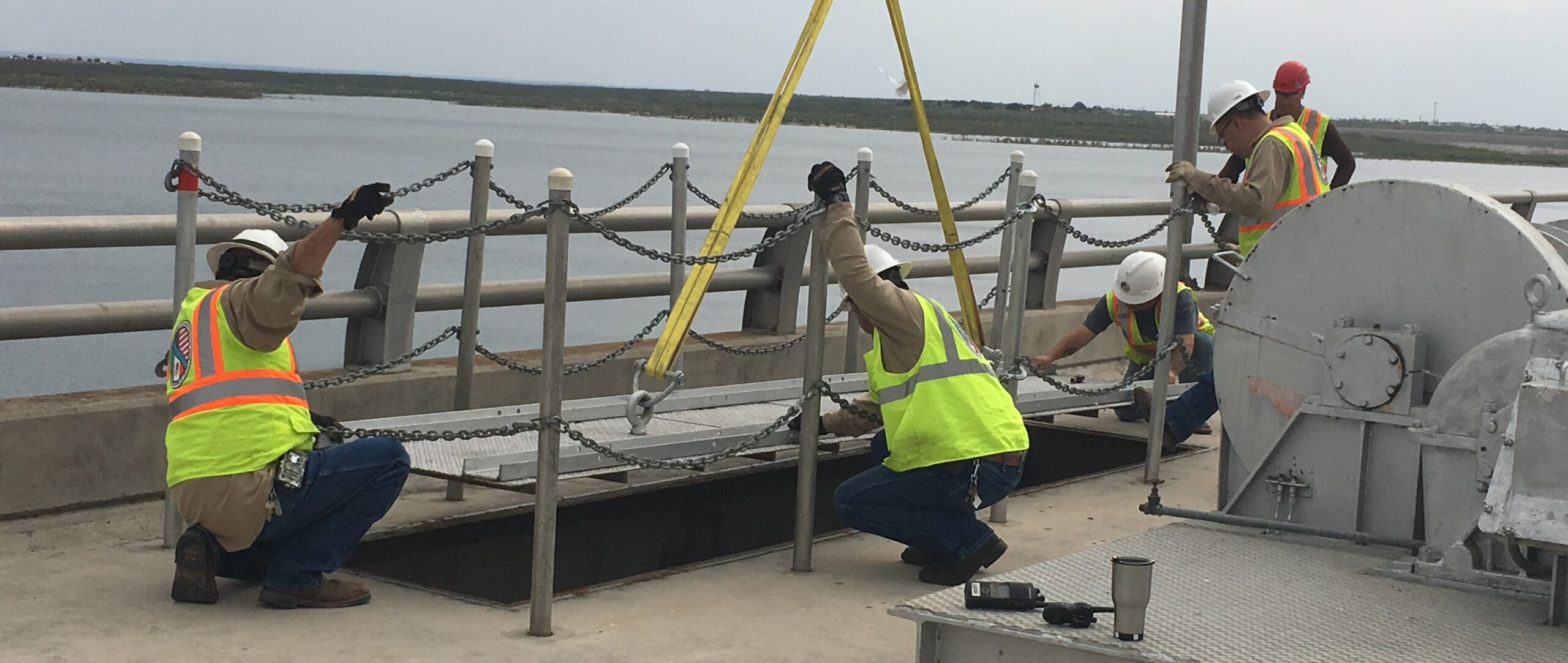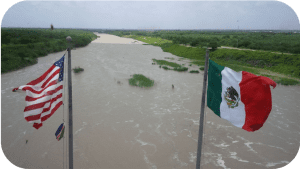Home > Organization >
Operations Department
The primary function of the Principal Engineer, Operations is to guide and direct all field activities of the USIBWC. The Principal Engineer of the Operations Department occupies a position established by treaty between the United States and Mexico and is responsible for guiding, directing, coordinating managing all USIBWC hydrographic, hydrologic, and water accounting activities, project planning and development, field operation, boundary monumentation, Security Operations, Occupational Safety and Health, activities, and operations and maintenance. The Office is also responsible for extensive negotiations, discussions, agreements, and joint operations involving other U.S. Federal agencies, domestic state and local governments, congressional offices, public interest groups, the Mexican Section and related Mexican agencies.
The Principal Engineer provides technical and policy advice to the United States Commissioner and monitors field activities of the USIBWC to assure adherence to treaty requirements.
Functions for which this office is responsible include, but are not limited to, the following:
- Development and issuance of management policy statements, guidance, and procedural manuals for all field activities and Headquarters’ engineering activities;
- Directing flood control activities;
- Providing assurance that USIBWC Headquarters engineering and field activities conform to the laws, rules and regulations which regulate all activities of the USIBWC;
- Serving as the USIBWC’s technical expert for the review and preparation of reports and recommendations regarding water accounting at all levels;
- Coordinating the project O&M and Hydrographic planning and development activities of the USIBWC;
- Assuring the development and issuance of the policy statements, guidance, and procedures for water operations and all field activities throughout the USIBWC; and
- Assuring the application of environmental regulations to all project activities including both construction and operation and maintenance functions.
Security Operations
“The mission of the Security Services Division (SSD) is to prevent terrorist attacks, reduce asset vulnerability to theft, protect organization employees, minimize the loss of life and damage to critical infrastructure, and recover from attacks or natural disasters should they occur.”
The SSD supports the USIBWC’s strategic goals by providing training, guidance and oversight of Security programs to mitigate hazards and threats to USIBWC personnel, assets, and facilities.
The duties of the Security Services Division include, but are not limited to:
- Insider Threat Program: Detection of potential or real insider threats to the agency or its personnel.
- Personnel Security: Conducts background investigations of employees and contractors.
- Physical Security: Provide policy and measures to deter and detect intruders at agency facilities.
- Critical Infrastructure Protection: Provide protective measures, policy, and procedures. Conduct risk management methodologies to mitigate risk to agency infrastructure.
- Anti-terrorism: Defensive measures used to reduce the vulnerability of personnel, assets, and agency facilities to terrorist acts, to include limited response and containment by agency security forces.
- Intelligence/Information Sharing: Collaborate with other government agencies to ensure the real-time and relevant sharing of intelligence information that may affect agency operations.
- Security Force Management: Train, equip, and employ armed federal response personnel to respond to safety and security incidents at various facilities and agency property.
- Security Awareness & Training: Provide awareness and training for all agency employees, increasing their knowledge and ability to respond to security threats.
- Investigations: Provide the agency with an effective system of independent and objective internal oversight that is designed to improve the effectiveness and efficiency of agency’s operations in achieving its mission, goals, and objectives through the provision of investigation services.
- Special Projects: Provide specialized support to agency missions through skilled program and project management.
Contact Information
Esteban Martinez, Acting Chief, Security Services Division
Office: (956) 825-0616
Danny Mendoza, Assistant Chief Security Officer
Office: (915) 832-4178
Occupational Safety and Health Program

 The Safety and Health (S&H) program has been developed to protect the safety and health of USIBWC employees, employees of other affected organizations when they are in USIBWC controlled workplaces, and the general public; minimize property damage, avoid unacceptable delays or negative impacts to the USIBWC due to accidents; and comply with applicable requirements related to Safety and Health issues. Provides the framework for development of procedures, manuals, rules, and programs necessary for implementation of an integrated Safety and Health program.
The Safety and Health (S&H) program has been developed to protect the safety and health of USIBWC employees, employees of other affected organizations when they are in USIBWC controlled workplaces, and the general public; minimize property damage, avoid unacceptable delays or negative impacts to the USIBWC due to accidents; and comply with applicable requirements related to Safety and Health issues. Provides the framework for development of procedures, manuals, rules, and programs necessary for implementation of an integrated Safety and Health program.
The duties of the Safety and Health Division include, but are not limited to:
- Hazard Recognition and Control - The S&H program is a continuous effort to eliminate unsafe workplace conditions and control unsafe acts by employees.
- Review Program - When designs, equipment/material specifications or operating plans are developed, the document originator will fully consider all S&H requirements in purchasing equipment, developing a design, or conducting an activity.
- Hazard Analysis - A Preliminary Hazard Analysis is conducted prior to commencement of all large-scale projects to ascertain if there are risks that are unacceptable or that previously have not been recognized and evaluated.
- Safety Procedures - The S&H office is responsible for developing and maintaining occupational safety procedures.
- Work Site Control - Each work site is controlled by an O&M department and supported by the S&H office. The field office organization that controls the work site will establish the appropriate safety procedures for the conduct of activity on that site and any necessary access controls for the site.
- Industrial Hygiene Workplace Monitoring & Control Principles - Recognition of potential problems with Respiratory Protection, Hearing Conservation, Hazard Communication Program & Ergonomic Program and any environmental agents or conditions in workplaces that have the potential to cause adverse health effects is the first objective of the industrial hygiene program.
Operations & Maintenance
The Operations and Maintenance Division (O&M) consists of nine USIBWC Field Offices located along the Rio Grande & Colorado Rivers, and a Headquarters O&M Staff. There are approximately 150 employees within the O&M Division. The O&M Division Engineer is responsible for the oversight, management and supervision of the field offices and administration of rehabilitation projects consisting of: Safety of Dams, Heavy Equipment Replacement, Facilities Renovations, and land boundary demarcation enhancements.
The functions of the field offices are flood protection, water conservation, hydrographic data collection, hydroelectric power generation, waste water treatment, water quality monitoring, international boundary demarcation and monitoring. Mission functions are accomplished through the Operation and Maintenance of the following:
- Levee and floodway systems
- International storage dams and reservoirs
- Hydro electric power generation plants
- International wastewater treatment plants
- River gaging stations
- Boundary monumentation
- All related structures and facilities
Water Accounting Division
Water Accounting Division supports many treaty missions of the Commission. As name implies, we assure treaty compliance with respect to the binational accounting of water between United States and Mexico. The Division also assures that the United States delivers allocated treaty water to Mexico from both the Rio Grande and Colorado rivers pursuant to the Convention of 1906 and the 1944 Water Treaty, respectively. The Division maintains a telemetry network of approximately 100 gaging stations to support treaty compliance and flood operations missions of the Commission. The Division has a staff of over twenty dedicated hydrologist/hydrotechs to support the various water management missions of the agency.






